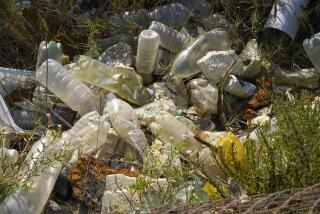This new technique could change the future of biodiesel

Researchers transformed components of rapeseed oil to create a biodiesel fuel. (Rahkendra Ice / AAAS)
Inspiration can strike in the most unlikely places. It struck chemist Lukas Goossen at a biodiesel factory in Rwanda.
Goossen was visiting the factory to see how it produced fuel from local plants. But he was surprised to learn that only one specially constructed bus was capable of running on pure biodiesel.
The fuel might be environmentally friendly, he thought, but what good would it do if regular vehicles couldn’t use it? He set out to use his know-how to make a plant-based fuel that could work in a normal diesel engine.
“Can I help with chemistry?” he wondered.
The answer turned out to be yes. After Goossen returned to his lab at Ruhr-University Bochum in Germany, his team developed a biodiesel fuel that works like regular petrodiesel and meets European standards for diesel engines.
The key to the new recipe, described Friday in Science Advances, was a mixture of catalysts that changed the sizes of the molecules in the fuel.
Both standard petrodiesel and biodiesel contain long chains of carbon atoms; the main difference is the length of those chains. Petrodiesel is a mixture of chains of various sizes, while the chains in unmodified biodiesel all contain around 18 carbon atoms, Goossen said.
To understand why size matters, let’s go back to high school chemistry.
Small molecules boil at lower temperatures than big ones. Because petrodiesel contains molecules of different sizes, it boils steadily over a wide range of temperatures — the smaller ones boil at around 350 degrees Fahrenheit, while the longer ones boil closer to 660 degrees.
But since the molecules in biodiesel are all the same size, they all want to boil at the same time. That’s a problem for diesel engines: The fuel can’t all boil at once. If it tries to, it can damage the engine and result in increased emissions. (This is why biodiesel can make up only 5% to 20% of a diesel blend.)
Goossen realized he could build a better biodiesel if he could mix up the size of its molecules. As it happened, he had been working on a reaction with the potential to fix this problem. The reaction breaks molecules apart, shuffles the broken pieces around, and fits them back together.
To test the idea, Goossen and some of his students went to the grocery store and bought some ordinary rapeseed oil to use in their reaction. Sure enough, it worked as if the researchers had fed the big molecules to a microscopic paper shredder, then taped random pairs back together. The result was a wide distribution of molecule sizes, which in turn changed the boiling behavior.
Goossen and his colleagues used computer models and small-scale tests to come up with just the right combination of catalysts to make their rapeseed biodiesel combust like petrodiesel. They didn’t have enough to drive a normal car, but the fuel was able to turn a propeller that powered a model car across a plaza.
The work isn’t done. Though the new biodiesel can work in petrodiesel engines, it might degrade those engines over time. Goossen said further tests would be needed to find out.
Another potential problem is that the reaction doesn’t remove certain oxygen-containing components called esters. These tend to attract water and could pose problems for the transport and long-term storage of biodiesel fuel, according to Allen Schaeffer, executive director of the Diesel Technology Forum in Frederick, Md.
Schaeffer and Dev Shrestha, an agricultural engineer who researches biofuels at the University of Idaho in Moscow, noted that there is already a renewable, or “green,” diesel that is made entirely from plant sources and can be used in standard diesel engines.
But Shrestha, who was not involved in the study, said it was valuable for demonstrating a low-temperature way of making biodiesel that could be cheaper than current methods.
Aside from this achievement, Goossen said his favorite thing about this project was that it gave him the chance to use chemistry for the common good.
“Sometimes I just have an idea for a new chemical process,” he said. “That process can be cool but absolutely meaningless if it doesn’t do anything good for you.”
Follow me on Twitter @mirakatherine and “like” Los Angeles Times Science & Health on Facebook.
MORE IN SCIENCE
What happens when scientists leave their labs to experiment with politics?
Chinese satellite breaks a quantum physics record, beams entangled photons from space to Earth
How oxygen-producing pond scum could save your life after a heart attack




